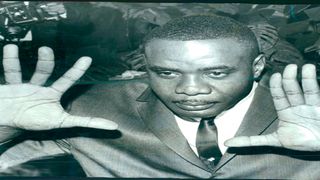
Boxer Sonny Liston.
| File | Nation Media GroupBoxing
Premium
Remembering Sonny Liston, former world champ with fist of cannonballs
What you need to know:
- American boxer defied tough childhood and run-ins with police to become heavyweight champion of the world
- Beyond his legendary fist that has no equal and has survived tests of time, it is like a miracle how he survived from extreme poverty to shake the world
The current crop of our boxing fans have interesting comments they make when randomly asked to name the greatest heavyweight boxers they can remember. Names like Muhammad Ali, Mike Tyson, George Foreman among a few others will crop up.
Few, and depending on their knowledge about the history of boxing will mention Charles Sonny Liston, a former heavyweight boxing champion of the world from the United States of America who died about 53 years ago in mysterious circumstances just as his correct date of birth remains unknown to date.
Recent research on Liston mainly from the internet shows amazing flow of information through books on him, comments from sports writers and many other people from various parts of the world who believe something needs to be done to accord the man the respect he deserved when he was alive despite the rough and negative side of life - partly due to neglect by the American society.
Many Kenyan boxing officials and seasoned boxers remember Liston well. Reuben Ndolo, the chairman Kenya Professional Boxing Commission (KPBC), himself a former heavyweight boxer weighing about 220 pounds, six feet in height and with an 13.8- inch fist in circumference, says Liston had a very powerful jab that did a lot of damage to his opponents.
Steve Omondi, a sub-editor with Nation Media Group, is one among non-boxers who can easily make it as a heavyweight boxer if he chose to do so. Weighing 120kg, a fist measuring 13.6 inches in circumference and 5’ 10’’ in height, he would be a threat to many boxers.
On the other hand, Liston stood at 6’1’’, weighed 220 pounds, and had an amazing reach of 84’’which was more superior than those taller than him. Above all, he had a fifteen and a half- inch fist around, which was the largest of any heavyweight champion.
Sports Illustrated once wrote that his hands “looked like cannonballs when he made them into fists.”

World heavyweight boxing champion Sonny Liston (left) follows through after landing a left blow to the head of challenger Roger Rischer in their bout in Pittsburgh on November 12, 1968. Liston knocked out Rischer in the third round.
I had an opportunity to meet two of the boxers Liston fought to win and lose his heavyweight title. Floyd Patterson was the world heavyweight champion and the youngest to have won it at 22, and was destroyed by Liston in one round on September 25, 1962 in Chicago. It lasted only two minutes and six seconds.
The rematch with Patterson took place in Las Vegas on July 22, 1963, several months after Liston and his wife Geraldine relocated from Philadelphia to Denver, saying he was tired of police harassment. Liston again knocked out Patterson in the first round.
Liston’s second defense of his title did not go as smoothly. Convinced that a brash kid called Cassius Clay was no threat, Liston hardly trained for their February 25, 1964 bout.
The boxing world was stunned when Liston failed to come out for Round 7. While there were cries that Liston threw the fight, the 7-1 favourite cited a shoulder injury as the reason he could not continue.
Their rematch took place on May 25, 1965, in Lewiston, Maine, and this time there was even more sentiment that the fight was fixed. Muhammad Ali, who had already changed his name, floored Liston with a short chopping right to the head in the first round. Liston fell, rolled over, climbed to his knees, and then fell again.
Referee Jersey Joe Walcott never counted to 10, but while trying to get Ali into a neutral corner, at least 17 seconds passed. When Liston finally rose, the fight resumed. However, when Walcott was told by a journalist how long Liston was down, he raised Ali’s hand in victory.
Ali and Patterson visited Kenya in 1980 and 1983 respectively on different missions and I had an opportunity to discuss with each one of them a wide range of issues without mentioning their battles with Liston. One thing I learnt from Patterson was that he was a quiet gentleman who always wanted to see things done the right way without hurting anybody’s feelings.

Boxer Sonny Liston.
A good example was when he was checking out of his hotel room at Hilton Hotel in Nairobi and a waiter was helping him carry his suitcases to the lobby. He called me aside and asked me in a whisper: “Roughly how much is enough to give as a tip?” The guy to be tipped was just next to where we were but I made sure he did not hear what we were discussing. I told Patterson we did not have a tipping formula in Kenya and that the choice was his if he had to tip.
He was happy as he handed over the dollar note in his hand to the hotel waiter who bowed respectively and walked away, smiling. Tipping in America is like a ritual and a waiter can shout at a customer demanding to know where the tip was.
Back to the world of Charles Sonny Liston and the lessons Kenyans and the world in general can continue learning. Beyond his legendary fist that has no equal and has survived tests of time, it is like a miracle how he survived from extreme poverty to shake the world- mostly the wrong way.
According to some information from a book “ The Devil and Sonny Liston,’’ by Nick Tosches, Liston’s formative years were spent growing up as a physically and mentally abused child living in a forsaken parch of land known as Sand Slough, Ark, in rural Arkansas.
Liston was the 12th of 13 children born to Tobe and Hellen Liston and 24th of 25 children from two wives. Birth certificates were not legal requirements at the time and so Liston did not have one. He was probably born in 1929, but no one knows for sure. Even his mother, who was called Big Hela, didn’t know, though she believed he was born during the month of January. Liston would later claim his birth date to be May 8, 1932, but that is off by at least two years.
By all accounts, Liston had a woeful childhood. Tobe was mean to his children, and especially to Sonny. From the time he was old enough to be useful in the fields, Sonny was a labourer to his tenant farmer father. Sonny, who was known by his proper name Charles while growing up, rarely attended school and never learnt to read or write, a fact that haunted him as an adult and fed a lifelong problem with insecurity.
As Toches brings out in his book, Liston’s brooding temperament can be explained in part by his insecurity. It was a defence mechanism designed to keep people from getting too close.

In this May 25, 1965 file photo, heavyweight champion Muhammad Ali stands over fallen challenger Sonny Liston, shortly after dropping Liston less than two minutes into the first round of their heavyweight title fight, in Lewiston, Maine.
As a child, he was beaten at home and struggled at school.
“We hardly had enough food to keep from starving, no shoes, only a few clothes and nobody to help us escape from the horrible life we lived,’’ he would later say. ‘’We grew up like heathens.’’
The young Liston was teased relentlessly because he was unable to read or write. and, when his family upped sticks and moved from Arkansas to St Louis, he abandoned education and turned to crime.
The police were forever chasing him and had his photograph stapled to the inside of the visor in their cars. He was in trouble with the police quite a bit.
In one early incident, he made his disdain for the police clear while demonstrating his remarkable strength.
“He started a fight with a cop, beat the cop senseless, snatched his gun, picked him up and dumped him in an alley,’’ recounts Jonathan Aig in Muhammad Ali: A Life.
“Liston then walked away smiling, wearing the cop’s hat.’’
His first serious conviction was for armed robbery when he was about 22.He was sent to Missouri State Penitentiary where his natural athleticism and talent for fighting were soon spotted by Father Alois Stevens, a Catholic priest who also ran the prison gym.
“He was the most perfect specimen of manhood I had ever seen,” Stevens later told Sports Illustrated. “Powerful arms, big shoulders. Pretty soon he was knocking out everybody in the gym. His hands were so large! I couldn’t believe it.’’
After two years in jail he was freed on parole and in in 1953 he turned professional. But his newfound freedom was short-lived as the Mob, which would go on to dominate his career and later life, quickly claimed him as their own. They would, according to boxing historians, manage his every fight and control his every earned dollar.
There is more on Liston that the world will continue to hear. But one thing is clear. Despite his so many shortcomings is life, he tried his best to demonstrate his positive side of his life but many in the society failed him. His grave has a message- simple and clear: CHARLES “SONNY” LISTON, 1932 - 1970, “A MAN.’’




